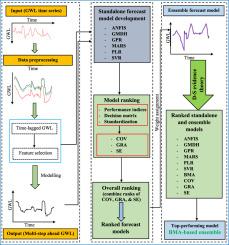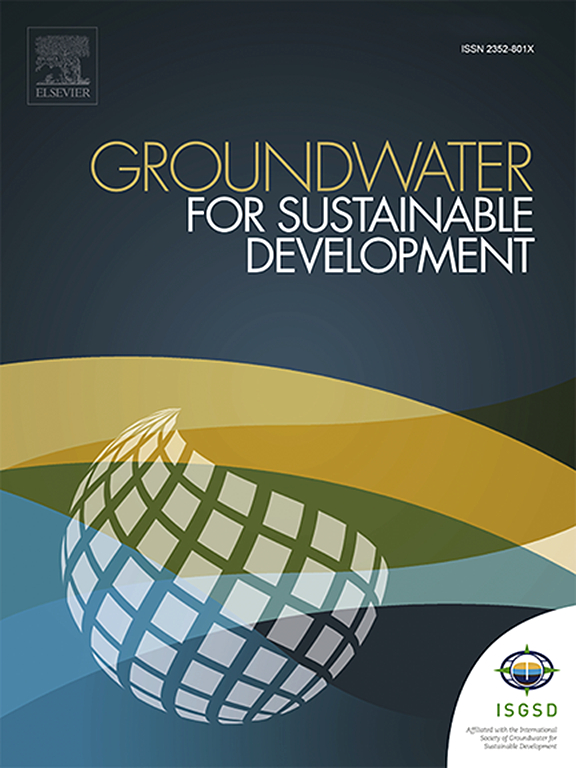利用多模型集合方法进行多尺度地下水位预测:利用决策理论和贝叶斯模型平均法组合机器学习模型
IF 4.9
Q2 ENGINEERING, ENVIRONMENTAL
引用次数: 0
摘要
创建精确的地下水位(GWL)预测模型对于有限的地下水供应的生产利用、扩展规划和控制具有至关重要的意义。在这项研究中,利用机器学习(ML)模型集提高了孟加拉国三周内地下水位预测的准确性。研究人员开发了六种先进的基于 ML 的模型,并使用八项性能指标对其进行了评估,综合灰色关系分析 (GRA)、变异系数 (COV) 和香农熵 (SE) 得出了综合排名 (OR)。独立预测模型在三个预测范围内均表现出色,在 GT3330001 上,一步预测的准确度值为 0.986 至 0.997,两步预测的准确度值为 0.971 至 0.999,三步预测的准确度值为 0.960 至 0.997。结果还显示,三种排序技术(SE、COV 和 GRA)以及它们的组合排序(OR)在不同观测井的不同预测范围产生了不同的最佳模型。通过使用四种集合建模技术计算单个模型的权重,建立了加权平均集合预测模型:SE、COV、GRA 和贝叶斯模型平均(BMA)。基于 BMA 的集合技术优于三种基准集合方法,在 GT3330001 的一步前预报中,R = 0.947,KGE = 0.925,IOA = 0.972,MAE = 0.062 m,RMSE = 0.123 m。这些结果在其他预测范围和观测井中呈现出一致的趋势。最后,采用 Dempster-Shafer 证据理论对单一模式和复合模式进行排序。排序结果表明,基于 BMA 的集合模型在所有预测范围和观测井中一直稳居榜首(在 GT3330001 的一周、两周和三周前瞻预测中的权重值分别为 0.997、0.991 和 0.987)。这项研究表明,基于 BMA 的复合模型可以对孟加拉国研究地点的 GWL 进行更准确的预测,并有可能应用于全球其他地区。本文章由计算机程序翻译,如有差异,请以英文原文为准。

Multiscale groundwater level forecasts with multi-model ensemble approaches: Combining machine learning models using decision theories and bayesian model averaging
Creating precise groundwater level (GWL) prediction models is of crucial significance for the productive use, extended planning, and controlling of limited sub-surface water supplies. In this research, the accuracy of GWL forecasts in Bangladesh was enhanced for three weeks by utilizing ensembles of Machine Learning (ML) models. Six advanced ML-based models were developed and assessed using eight performance indices, and an Overall Ranking (OR) was provided by combining the rankings produced by Grey Relational Analysis (GRA), Variation Coefficient (COV), and Shannon's Entropy (SE). The standalone forecasting models demonstrated excellent performance across the three forecasting horizons, with accuracy values ranging from 0.986 to 0.997 for one-step, 0.971 to 0.999 for two-step, and 0.960 to 0.997 for three-step forecasts at GT3330001. Results also revealed that three ranking techniques (SE, COV, and GRA), as well as their combined ranking (OR), produced different best-performing models at different prediction horizons for different observation wells. Weighted average ensembles of the prediction models were developed by calculating individual model weights using four ensemble modelling techniques: SE, COV, GRA, and Bayesian Model Averaging (BMA). The BMA-based ensemble technique outperformed three benchmark ensemble approaches, achieving R = 0.947, KGE = 0.925, IOA = 0.972, MAE = 0.062 m, and RMSE = 0.123 m for one-step-ahead forecasts at GT3330001. The findings exhibit a consistent trend across other forecasting horizons and observation wells. Finally, the Dempster-Shafer evidence theory was employed to rank the single and composite models. The ranking results demonstrated that the BMA-based ensemble consistently secured the top position (with the weight values of 0.997, 0.991, and 0.987 for one-week, two-weeks, and three-weeks forward forecasts at GT3330001) for all forecasting horizons and observation wells. This study shows that the BMA-based composite model can produce more accurate GWL projections at Bangladesh study location, with potential for application in other regions worldwide.
求助全文
通过发布文献求助,成功后即可免费获取论文全文。
去求助
来源期刊

Groundwater for Sustainable Development
Social Sciences-Geography, Planning and Development
CiteScore
11.50
自引率
10.20%
发文量
152
期刊介绍:
Groundwater for Sustainable Development is directed to different stakeholders and professionals, including government and non-governmental organizations, international funding agencies, universities, public water institutions, public health and other public/private sector professionals, and other relevant institutions. It is aimed at professionals, academics and students in the fields of disciplines such as: groundwater and its connection to surface hydrology and environment, soil sciences, engineering, ecology, microbiology, atmospheric sciences, analytical chemistry, hydro-engineering, water technology, environmental ethics, economics, public health, policy, as well as social sciences, legal disciplines, or any other area connected with water issues. The objectives of this journal are to facilitate: • The improvement of effective and sustainable management of water resources across the globe. • The improvement of human access to groundwater resources in adequate quantity and good quality. • The meeting of the increasing demand for drinking and irrigation water needed for food security to contribute to a social and economically sound human development. • The creation of a global inter- and multidisciplinary platform and forum to improve our understanding of groundwater resources and to advocate their effective and sustainable management and protection against contamination. • Interdisciplinary information exchange and to stimulate scientific research in the fields of groundwater related sciences and social and health sciences required to achieve the United Nations Millennium Development Goals for sustainable development.
 求助内容:
求助内容: 应助结果提醒方式:
应助结果提醒方式:


